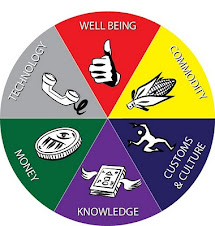What if, for one second, the experts assembling in Copenhagen decided that our supreme deity did not animate all creation with the single eucharist called electricity? What if, for one second, we considered the madness of our consensus dogma that holds that all that is energy must pass through copper? Yes, even those who are advocating for cleaner energy. Can you consider the futility of the reductionism that is the genuine opiate of the masses?
Remember, to refrigerate is to create variable pressure. Heat can as readily come from focused optics, from oxidation of fuel, or from the application of a charge to a resistive conductor or ceramic. Animation of mechanical parts involves selective gradients of friction and smoothness. You see, while we lament the destruction of our Earth and its ecosystem, we still obsess with our unifying principle that for anything to achieve acceptable modernity, it must be denominated in kilowatts.
Where is the ethical call for eliminating the outlet and the plug as the arbiter of advanced? When can we incentivize those who assemble appliances with rewards for linking power harnessing with end use with as few steps between production and use as possible?
Recent pronouncements have celebrated the amount of venture capital and private equity that has been invested in climate friendly technologies. As electricity is to our obscurity above, so is venture capital to our impulse to incentivize. However, let’s review, for the bidding. Venture capital deployed in new enterprises historically operates with a notoriously horrific efficiency (>90% failure). Not to worry, we are told. Because the less than 10% that make it make up for the 90% that fail. But do they really? Is this a tested hypothesis or is this consensus myth. The data, regrettably provides conclusive evidence of the latter. In fact, over the past seven years, bets taken on enterprise value erosion or full enterprise failure, exceeded all venture capital by two orders of magnitude and bets against future performance in the private equity markets outstripped forward fruitfulness bets 5 to 1. And these statistics are derived from markets where public offerings on stock exchanges and merger and acquisition liquidity is a mature market. How then, can any climate advocacy initiative have ANY credibility if it is suggesting that venture capital models are a key to helping the world escape its destructive tendencies? We are using the most inefficient form of capital to build the most inefficient appliances to feed from the most inefficient consensus utility created in our march toward evolutionary ecstasy. A pledge for $10 billion per year for 10 years to put in the hands of private equity in emerging markets is nothing short of another subsidy for the incumbent financial marketeers and is an affront to illumined social interest.
When will we deploy capital that is explicitly linked to taking to scale those technologies that are ecosystem aligned but grid incompatible? When will we invest not in usurious passive private equity (DC) which must be converted back into transmitted value (AC) so that it can be inefficiently consolidated for the utility of a few (DC again) but rather create innovative investments in forward purchase contracts on the production of future efficiency and the artifacts thus aligned? When will we think with more than one synapse at a time and engage our full creativity to free ourselves from our grid addiction on power (electricity) and power (capital accumulation)?
What we need is not the next commission laden bolus of cash from which private placement fees can further insulate those who have fed off the thermal loss of the systems that have empowered the last 100 years. When Edison and Westinghouse built the temple to whom all now must pay homage, few could have known the depth to which they would have enslaved even those who call themselves agents of change. As we look past the Klieg lights of Copenhagen (ironically, the illumination of carbon) and into the future of 2010 and beyond, I trust that at least a few understand that linking the source of energy to the intended use not only has merit for our appliances of convenience but also the appliances of our financial system.
_



.jpg)




No comments:
Post a Comment
Thank you for your comment. I look forward to considering this in the expanding dialogue. Dave